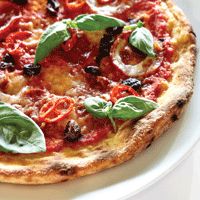Chefs are appealing to flexitarians, a new wave of vegetarians who eat meat
On The Big Bang Theory, one of TV’s successful sitcoms, Penny says, “I’m a vegetarian — except for steak. I loooove steak!” It draws a laugh, but Penny is not joking. She belongs to a new category of diners called flexitarians.
These consumers intend to be healthy and socially conscious (it takes significantly more of the Earth’s resources to feed a meat eater), so they espouse vegetarian principles. But, like Penny, they love the occasional indulgence of juicy meat.
There are good reasons to be flexitarian. Apart from the ethical concerns, studies show that people whose diets are primarily vegetarian are less prone to cholesterol problems, maintain a lower weight and live longer. As Canadians become more aware of health matters, and, as more and more of us age, these issues become paramount.
Although still small, the demand for vegetarian options is growing. Joel Gregoire, industry analyst, Food and Beverage for the NPD Group, says the percentage of Canadians who claim to be vegetarians is on the rise. “In the year ending March 2011, 2.6 per cent of Canadians identified themselves as being vegetarians, up from 1.5 per cent in 2005,” he says.
Chefs themselves have noted the trend. “In last year’s Chef Survey, vegan ranked high among the up-and-coming trends with vegetarian/meatless ranking fifth,” says Chris Elliott, CRFA’s senior economist, before adding, “I’ve seen numbers that vegetarians are about four per cent of the Canadian population (vegans are another one per cent).”
Gregoire points out that while those who classify themselves as vegetarians are less likely to eat meat, this doesn’t mean that it’s totally excluded from their diet. “For instance, vegetarians eat red meat 36 per cent as often as the total population and chicken 42 per cent as often. When it comes to incidences of fish, a comparison between vegetarians and non-vegetarians is nearly equal,” he says. “Clearly opportunities exist when it comes to the consumption of proteins among vegetarians, and clearly a number of vegetarians associate this lifestyle choice as a reduction in, rather than a full-on elimination of meats altogether.” And there you have the flexitarian.
Toronto cooking instructor and author, Nettie Cronish, sees flexitarian dining as the next major trend. As a vegetarian, she can attest to the fact that many restaurants give this group short shrift. “Recently, our family went to a well-known Toronto restaurant. I’m the vegetarian in the group,” she says. “They got beautiful, cumin-scented lamb, and I got a boring, tasteless eggplant dish. Too many restaurants just don’t make any effort for vegetarians.”
But, Cronish points out, it’s not simply a matter of offering vegetarian alternatives on the menu, “It goes way beyond adding a veggie burger or vegetarian lasagna.” What they should do, she suggests, is offer the same dishes, with the same beautiful flavour profiles, as both meat and vegetarian options. Her book, Everyday Flexitarian (below), co-authored by Pat Crocker, does exactly that.
Cronish appears to be on the mark. Companies such as Sodexo and Compass Group Canada are including vegetarian and even vegan options on menus for their student-dining programs. More specifically, Compass Group Canada launched its trendsetting “Be a Flexitarian” initiative in 2010, expanding the quality and flavour of its meat-free menu options.
But while it’s making inroads in commercial catering, ‘flexitarian’ has only just begun to enter the vocabulary of restaurateurs. What does it really mean to a restaurant? It’s hard to pinpoint.
“I can accommodate someone who says they want gluten-free or even vegan,” says Ian Sorbie, president of Il Fornello, an eight-unit chain based in Toronto. “But my whole menu is flexitarian. If they want vegetarian, it’s there. If they want meat, it’s there.”
But, to Cronish, being flexitarian would mean offering, for example, Il Fornello’s Linguine Pollo Pesto ($18) — a blend of pasta with grilled chicken, roasted cherry tomatoes and pesto — as a vegetarian dish, so that the customer can enjoy essentially the same flavour profile without the meat. No problem, says Sorbie. Being flexible to requests from customers has been part of his company’s ethos from the outset.
Can you tailor a menu as Cronish suggests? The Woodlot is a tiny Toronto bistro, which does in fact support parallel vegetarian and meat menus. “Our chef, David Haman, has worked all over the world, so he uses a lot of spices. And we’re committed to using local, sustainable ingredients seasonally,” says owner, Robyn Donio. “Being so small, it’s difficult to have two menus, but we wanted to bring some respect and good taste to both vegetarian and meat dishes.” For example, this week’s meat menu might feature spiced lamb pie with winter roots, apricots and currants ($25) while the vegetarian menu has roasted tofu and wild mushroom pie with sherry cream, winter roots and Swiss chard ($24). Both menus might have baked caramelized onion soup with aged gruyère and red-fife sourdough bread ($11) because the broth is vegetarian, but the cheese can be changed for vegans.
The orders from the two menus run about 50/50. But when asked why people come to The Woodlot, Donio says, “Some people come because it’s vegetarian or because we’re careful to source locally, but I think it’s [mainly] because the food tastes good. When you use seasonal and local ingredients, the food tastes better from the start.”
Donio has hit on a key flexitarian concern. Because the segment has ethical and health concerns, the group tends to prefer local ingredients, organic, when possible, and nutritious. And they might want to eat meat, but they don’t want excessive amounts of it. So responding to this might mean creating dishes with only 3-to-4 ounces of meat in the meat option.
More importantly, however, “It’s about understanding where your food comes from,” says John Lettieri, founder and CEO of Hero Certified Burgers, which has 28 units in and around Toronto. “If you know the cattle is ethically raised, without antibiotics and hormones, you can feel good about eating meat.” Hero’s burgers are made with traceable meat, and the buns and toppings are also sustainably produced. At $4.99 for a 4-oz., $5.99 for a 6-oz., $6.99 for an 8-oz. burger, it offers economy as well. It’s even certified Halal. But for those who prefer to eschew red meat, the chain also offers a veggie burger, chicken and Alaskan salmon in a bun.
It’s also interesting to note that in steak restaurants, traditional bastions for carnivores, vegetarian options are finding their way onto the menu. Glowball Grill Steaks & Satay in Vancouver defines itself as steak-centric, but the Satay menu includes mushroom tempura and among its signature dishes is wild mushroom risotto with parmigiano reggiano ($17.95). Chop Steakhouses, with six locations in Manitoba, Alberta and British Columbia, makes few concessions to vegetarians in the group, but under the Chop House Favourites, you’ll find artisan ravioli stuffed with roasted portobello and cremini mushrooms in a creamy white wine, sage and butter sauce, finished with asiago cheese ($16).
In the heart of cattle country, Calgary’s Vintage Steakhouse is one of very few of that ilk that offers anything even remotely vegetarian — truffled mac and cheese made with truffle oil and smoked cheddar ($22) is a specialty, and it can come with lobster ($37) for those who eat seafood. What is more surprising is that, despite its focus on meat, the main webpage of this steakhouse launches with a gorgeous photo of heirloom tomatoes and crumbled cheese.
Meat lovers in Banff head to The Bison, where the menu is all about meat, but also offers an appetizer of pumpkin ravioli ($14) and a rather unique take on the traditional Beef Wellington in the form of Mushroom Wellington — Ponderosa Farm mushrooms sautéed and wrapped in puff pastry and served with butter-poached potato hash and red pepper purée ($24).
And, at Charcut, a Calgary restaurant whose name says it all, chef John Jackson offers a range of vegetarian options. One recent menu included risotto with oven-roasted tomatoes, basil, mascarpone and Sky Hawk olive oil ($19 for small, $24 for large). “We’re known for our meat, but we have regular vegetarian customers,” he explains. “Our menu changes daily, and we always have dishes like risotto with roasted local heirloom squash. If someone really wants the pasta dish, we’ll make it vegetarian, maybe using Okanagan black walnuts instead, but keep the integrity of the original intent of the dish.”
At the other end of the country, Ryan Duffy, one of the premier steak spots in Halifax, offers a lone vegetarian entrée — spinach-and-ricotta stuffed cannelloni baked in a fire-roasted tomato sauce, with herbs, crème fraiche and mozzarella and parmesan cheeses ($19.95).
And, at Raymonds, an upscale eatery in St. John’s, N.L., chef Jeremy Charles champions “beautiful local, Newfoundland food.” He offers a vegetarian dish each day, “But one of our most popular dishes is a fish variation of a traditional Newfoundland Sunday meat meal, the Jiggs Dinner,” he explains. “Ours is made with local pan-seared codfish with carrots, pea pudding, cabbage and vanilla turnip purée.” For strict vegetarians, the dish of the day might be pasta with chanterelles and asparagus with a touch of truffle oil ($18), or a vegetable tian, a lasagna-style stack of roasted peppers, eggplant, confit of tomatoes, caramelized onions and more ($35).
Some chefs are starting to make the move to flexitarian themselves. Jérôme Ferrer, executive chef at Europea, Montreal’s chic bistro and the trendy Birks Café, used to eat meat daily, but these days he’s down to eating it a couple of times a week. When he started to look for good-tasting vegetarian recipes, he found these were rare. So he collaborated with actor Vincent Graton and nutritionist Isabelle Huot to produce a French-language cookbook Végétarien: parfois, souvent ou passionnément (translated: Vegetarian, Occasionally, Often or Passionately).
The book points out why it’s a good idea to eat less meat, both from a health and an environmental perspective. It also recommends a flexitarian lifestyle; then it sets out to provide truly delicious alternative recipes. Ferrer reinvents classics such as shepherd’s pie and lasagna without meat, and how about poutine, Quebec’s favourite dish? His is made with stir-fried sticks of firm tofu, local cheese curds and vegetarian barbecue sauce instead of the usual gravy.
Food has come a long way for those who prefer to eschew meat or cut back their consumption of it. “Back in the ’80s, it might have been a plate of vegetables for the vegetarian at the table,” says Charcut’s Jackson. “Today, we look to balance it out, making sure there’s an interesting protein on the plate.” And, for many, the alternative is interesting enough — and the health and ethical inducements significant enough — to encourage diners to choose those options. The question is, are they on the menu?
Keep Reading
Golden Opportunity: California Wines




















